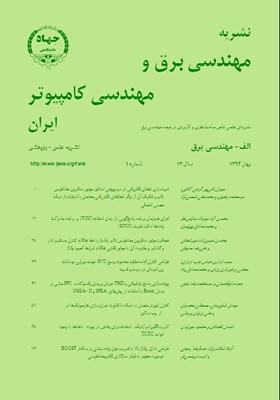طراحی شارژر ولتاژ بالا با ضریب توان واحد مبتنی بر ساختار BOOST دوسویه، مجهز به فیلتر سازگاری الکترومغناطیسی
محورهای موضوعی : مهندسی برق و کامپیوترآتيلا اسکندرنژاد 1 , عبدالرضا رحمتی 2 , سيداديب ابريشميفر 3
1 - دانشگاه علم و صنعت ايران
2 - دانشگاه علم و صنعت ایران
3 - دانشگاه علم و صنعت ایران
کلید واژه: تصحیح ضریب توان مبدل Boost سازگاری الکترومغناطیسی,
چکیده مقاله :
: شارژرهای ولتاژ بالا در وسایلی مانند خودروهای برقی (EV)،UPS و فضاپیما استفاده میشوند. مبدل معرفیشده دارای ساختار Boost دوسویه است که کل ولتاژ مجموعه باتری در خروجی بزرگتر از بیشینه ولتاژ ورودی بوده و این مبدل دوسویه قابلیت انتقال توان از منبع به بانک باتری و بالعکس را داراست. جریان در یک نیمسیکل از سمت ورودی به خروجی و در نیمسیکل دیگر از سمت خروجی به ورودی میباشد. تغذیه ورودی مدار منبع سینوسی برق شبکه و خروجی نیز ولتاژ DC میباشد، این مبدل عملکرد یکسوسازی AC/DC و تبدیل DC/DC را در یک مرحله تحقق میبخشد. کنترل سوئیچینگ به روش هیسترزیس انجام میگیرد و ضریب توان نزدیک به یک خواهد بود و روابط مداری برای تعیین مقادیر قطعات محاسبه میگردد. در ادامه فیلتر سازگاری الکترومغناطیسی (EMC) طراحی شده و در انتها سازگاری تحلیلهای تئوری بیانشده با انجام شبیهسازی روی یک مبدل نمونه تحقق مییابد و پیشنهادهایی برای کارهای آتی بیان میشود.
High voltage chargers are being used in the equipments such as electrical vehicles, uninterruptible power supplies and aircrafts. The converter introduced here is based on bi-directional boost topology. The output voltage of batteries set is larger than the input source voltage amplitude, and this converter can transfer the energy both from the source to the batteries bank and vice versa. Input source voltage is sine wave and the output voltage is DC. Both conversion of AC-to-DC and DC-to-DC is performed in one stage and the control scheme of switches is based on hysteric control method to achieve the unity power factor. One can use the electrical equations presented here to define the converter and EMC filter elements value. Finally, simulation results performed on a typical converter show the control method authenticity and effectiveness of the analyses presented here. Also some suggestion for the future works is proposed.
[1] A. Venkatesan, A. Mohan, K. Gayathri, and R. Seyezhai, "Comparative study of power factor correction in AC - DC converters," Int J. of Electrical, Electronics, and Data Communication, vol. 1, no. 1, pp. 12-17, Jan. 2013.
[2] S. C. Rajappan, K. Sarabose, and N. John, "An efficient AC/DC converter with power factor correction," Int. J. of Emerging Technology and Advanced Engineering, vol. 3, no. 3, pp. 815-820, Mar. 2013.
[3] ON Semiconductor, Power Factor Correction (PFC) Hand Book, www.onsemi.com, rev. 4, 2011.
[4] M. Warner, Electrical Vehicle Conversion Hand Book, Penguin Group USA, 2011.
[5] O. Dranga, C. K. Tse, and S. C. Wong, "Stability analysis of two stage power factor correction power supplies," in Proc. IEEE Euro. Conf. on Circuit Theory and Design, vol. 1, pp. 177-180, Aug. 2005.
[6] R. Oruganti and R. Srinivasan, "Single phase power factor correction - a review," Sadhana, vol. 12, no. 6, pp. 753-780, Dec. 1997.
[7] W. Xiaoqun, C. K. Tse, O. Dragna, and J. Lue, "Fast scale instability of single stage power factor correction power supplies," IEEE Trans. on Circuit and Systems, vol. 53, no. 1, pp. 204-213, Jan. 2006.
[8] M. R. Kumar, D. Lenine, and C. S. Babu, "A variable switching frequency with boost power factor correction converter," TELKOMNIKA Indonesian J. of Electrical Engineering, vol. 9, no. 1, pp. 47-54, Jan. 2011.
[9] S. W. Lee, S. R. Lee, and C. H. Jeon, "A new high efficient bidirectional DC/DC converter in the dual voltage system," J. of Electrical Engineering and Technology, vol. 1, no. 3, pp. 343-350, Sep. 2006.
[10] D. Shmilovitz, D. Czarkowski, Z. Zabar, and S. Y. Yoo, "A novel reversible boost rectifier with unity power factor," in Proc. IEEE Conf. APEC, vol. 1, pp. 363-368, 14-18 Mar. 1999.
[11] S. Maniktala, Troubleshooting Switching Power Converters, Newnes, 2007.
[12] EMC Standards, Federal Communications Commission (FCC), Part 15, http://www.ece.msstate.edu/~donohoe/ece4323EMCreq.pdf,2000
[13] S. Ye, W. Eberle, and Y. F. Liu, "A novel emi filter design method for switching power supplies," IEEE Trans. on Power Electronics, vol. 19, no. 6, pp. 1668-1678, Nov. 2004.


